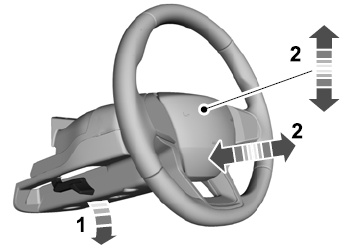Lincoln Aviator: Engine Ignition - 3.0L EcoBoost / Removal and Installation - Ignition Coil-On-Plug
Special Tool(s) /
General Equipment
Removal
-
Remove the retainers and the RH side engine compartment cover.
-
Remove the retainers and the LH side engine compartment cover.
-
Remove the bolts and the suspension support bar.
-
-
Remove the coolant pipe bracket retaining bolts.
-
Remove the intake manifold bracket retaining bolts.
Left side
-
NOTE:
The crankcase vent tube may have either a
permanent or quick connect connector at one or both ends. If the tube
needs to be removed for any reason, the permanent connector(s) must be
cut to remove the tube. The tube will then need to be replaced.
NOTE:
If the crankcase vent tube is replaced, the
replacement part may not come with a crankcase pressure sensor. If so,
the PCM will need to be reprogrammed.
-
If equipped, disconnect the wiring harness electrical connector.
-
If necessary, cut the lock tab.
Use the General Equipment: Side Cutter Pliers
-
Remove the crankcase vent tube.
-
If either crankcase vent tube connector was cut, discard the crankcase vent tube.
-
Release the electrical harness retainers from the
ignition coil-on-plug studbolts, then disconnect the ignition
coil-on-plug electrical connectors.
-
Use compressed air to remove any foreign material
from the ignition coil-on-plugs and surrounding area before removing the
ignition coil-on-plugs.
-
NOTE:
When removing the ignition coil-on-plugs, a slight twisting motion will break the seal and ease removal.
Remove the ignition coil-on-plug retaining studbolts, then remove the ignition coil-on-plugs.
Right side
-
Loosen the nut, detach the tag, position aside the hose and remove the fuel pump cover.
-
Remove the following items:
-
Detach the wire harness retainers from the studbolts.
-
Disconnect the ignition coil-on-plug electrical connectors.
-
Use compressed air to remove any foreign material
from the ignition coil-on-plugs and surrounding area before removing the
ignition coil-on-plugs.
-
NOTE:
When removing the ignition coil-on-plugs, a slight twisting motion will break the seal and ease removal.
Remove the ignition coil-on-plug retaining studbolts, then remove the ignition coil-on-plugs.
Installation
Both sides
-
Inspect the ignition coil-on-plug assembly for
cracks, rips or tears. Replace any damaged coil-on-plug assemblies.
Right side
-
Install the ignition coil-on-plugs, then install and tighten the ignition coil-on-plug studbolts.
Torque:
53 lb.in (6 Nm)
-
Connect the ignition coil-on-plug electrical
connectors, then attach the electrical harness retainers to the ignition
coil-on-plug studbolts.
-
Install the fuel pump cover, attach the hose tag, tighten the nut.
Torque:
44 lb.in (5 Nm)
Left side
-
Install the ignition coil-on-plugs, then install and tighten the ignition coil-on-plug studbolts.
Torque:
53 lb.in (6 Nm)
-
Attach the wire harness retainers to the studbolts,
and connect the ignition coil-on-plug electrical connectors.
-
-
Install the crankcase vent tube. If the
crankcase vent tube was previously discarded, install a new crankcase
vent tube.
-
If the replacement crankcase vent tube part comes with no crankcase pressure sensor, reprogram the PCM.
Refer to: Module Programming (418-01 Module Configuration, General Procedures).
-
If the replacement crankcase vent tube came
without a crankcase pressure sensor, tape the wiring harness electrical
connector back to the wiring harness.
-
If the replacement crankcase vent tube comes
with a crankcase pressure sensor, connect the wiring harness electrical
connector.
-
-
Install the coolant pipe bracket retaining bolts.
Torque:
97 lb.in (11
Nm)
-
Install the intake manifold bracket retaining bolts.
Torque:
97 lb.in (11
Nm)
-
Install the suspension support bar and the bolts.
Torque:
22 lb.ft (30 Nm)
-
Install the retainers and the LH side engine compartment cover.
-
Install the retainers and the RH side engine compartment cover.
Removal
Remove the ignition coil-on-plugs.
Refer to: Ignition Coil-On-Plug (303-07A Engine Ignition - 3.0L EcoBoost, Removal and Installation)...
Other information:
T..
Disconnect
WARNING:
Before beginning any service procedure in this
section, refer to Safety Warnings in section 100-00 General Information.
Failure to follow this instruction may result in serious personal
injury.
Refer to: Health and Safety Precautions (100-00 General Information, Description and Operation)...
.jpg)
.jpg)
.jpg)
.jpg)
.jpg)
.jpg)
.jpg)
.jpg)
.jpg)
.jpg)
.jpg)
.jpg)
.jpg)
.jpg)
.jpg)
.jpg)
.jpg)
.jpg)
.jpg)
.jpg)
.jpg)
 Removal and Installation - Spark Plugs
Removal and Installation - Spark Plugs

